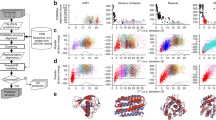Abstract
An important quantity that is measured in NMR spectro- scopy is the chemical shift. The interpretation of these data is mostly done by human experts. We present a method, named SimShiftDB, which identifies structural similarities between a protein of unknown structure and a database of resolved proteins based on chemical shift data. To evaluate the performance of our approach, we use a small but very reliable test set and compare our results to those of 123D and TALOS. The evaluation shows that SimShiftDB outperforms 123D in the majority of cases. For a significant part of the predictions made by TALOS, our method strongly reduces the error. SimShiftDB also assesses the statistical significance of each similarity identified.
This work was funded by the German Research Foundation (DFG, Bioinformatics Initiative).
Access this chapter
Tax calculation will be finalised at checkout
Purchases are for personal use only
Preview
Unable to display preview. Download preview PDF.
Similar content being viewed by others
References
Ginzinger, S.W., Fischer, J.: SimShift: Identifying structural similarities from NMR chemical shifts. Bioinformatics 22(4), 460–465 (2006), http://dx.doi.org/10.1093/bioinformatics/bti805
Alexandrov, N.N., Nussinov, R., Zimmer, R.M.: Fast protein fold recognition via sequence to structure alignment and contact capacity potentials. In: Pac. Symp. Biocomput., pp. 53–72 (1996)
Cornilescu, G., Delaglio, F., Bax, A.: Protein backbone angle restraints from searching a database for chemical shift and sequence homology. J. Biomol. NMR 13(3), 289–302 (1999)
Seavey, B.R., Farr, E.A., Westler, W.M., Markley, J.L.: A relational database for sequence-specific protein NMR data. J. Biomol. NMR 1(3), 217–236 (1991)
Zhang, H., Neal, S., Wishart, D.S.: RefDB: a database of uniformly referenced protein chemical shifts. J. Biomol. NMR 25(3), 173–195 (2003)
Chandonia, J.-M., Hon, G., Walker, N.S., Conte, L.L., Koehl, P., Levitt, M., Brenner, S.E.: The ASTRAL compendium in 2004. Nucleic Acids Res. 32(Database issue), D189–D192 (2004), http://dx.doi.org/10.1093/nar/gkh034
Neal, S., Nip, A.M., Zhang, H., Wishart, D.S.: Rapid and accurate calculation of protein 1H, 13C and 15N chemical shifts. J. Biomol. NMR 26(3), 215–240 (2003)
Henikoff, S., Henikoff, J.G.: Amino acid substitution matrices from protein blocks. Proc. Natl. Acad. Sci. 89(22), 10915–10919 (1992)
Holm, L., Sander, C.: Mapping the protein universe. Science 273(5275), 595–603 (1996)
Altschul, S.F., Gish, W., Miller, W., Myers, E.W., Lipman, D.J.: Basic local alignment search tool. J. Mol. Biol. 215(3), 403–410 (1990), http://dx.doi.org/10.1006/jmbi.1990.9999 , doi:10.1006/jmbi.1990.9999
Murzin, A.G., Brenner, S.E., Hubbard, T., Chothia, C.: SCOP: a structural classification of proteins database for the investigation of sequences and structures. J. Mol. Biol. 247(4), 536–540 (1995), http://dx.doi.org/10.1006/jmbi.1995.0159 , doi:10.1006/jmbi.1995.0159
Karlin, S., Altschul, S.F.: Applications and statistics for multiple high-scoring segments in molecular sequences. Proc. Natl. Acad. Sci. 90(12), 5873–5877 (1993)
Karlin, S., Altschul, S.F.: Methods for assessing the statistical significance of molecular sequence features by using general scoring schemes. Proc. Natl. Acad. Sci. 87(6), 2264–2268 (1990)
Ruzzo, W.L., Tompa, M.: A linear time algorithm for finding all maximal scoring subsequences. In: Proc. Int. Conf. Intell. Syst. Mol. Biol., pp. 234–241 (1999)
Haupt, M., Bramkamp, M., Coles, M., Altendorf, K., Kessler, H.: Inter-domain motions of the N-domain of the KdpFABC complex, a P-type ATPase, are not driven by ATP-induced conformational changes. J. Mol. Biol. 342(5), 1547–1558 (2004), http://dx.doi.org/10.1016/j.jmb.2004.07.060 , doi:10.1016/j.jmb.2004.07.060
Coles, M., Diercks, T., Liermann, J., Groger, A., Rockel, B., Baumeister, W., Koretke, K.K., Lupas, A., Peters, J., Kessler, H.: The solution structure of VAT-N reveals a ‘missing link’ in the evolution of complex enzymes from a simple βα ββ element. Curr. Biol. 9(20), 1158–1168 (1999)
Nicastro, G., Menon, R.P., Masino, L., Knowles, P.P., McDonald, N.Q., Pastore, A.: The solution structure of the josephin domain of ataxin-3: structural determinants for molecular recognition. Proc. Natl. Acad. Sci. 102(30), 10493–10498 (2005), http://dx.doi.org/10.1073/pnas.0501732102 , doi:10.1073/pnas.0501732102
Frishman, D., Argos, P.: Knowledge-based protein secondary structure assignment. Proteins 23(4), 566–579 (1995), http://dx.doi.org/10.1002/prot.340230412 , doi:10.1002/prot.340230412
Author information
Authors and Affiliations
Editor information
Rights and permissions
Copyright information
© 2007 Springer Berlin Heidelberg
About this paper
Cite this paper
Ginzinger, S.W., Gräupl, T., Heun, V. (2007). SimShiftDB: Chemical-Shift-Based Homology Modeling. In: Hochreiter, S., Wagner, R. (eds) Bioinformatics Research and Development. BIRD 2007. Lecture Notes in Computer Science(), vol 4414. Springer, Berlin, Heidelberg. https://doi.org/10.1007/978-3-540-71233-6_28
Download citation
DOI: https://doi.org/10.1007/978-3-540-71233-6_28
Publisher Name: Springer, Berlin, Heidelberg
Print ISBN: 978-3-540-71232-9
Online ISBN: 978-3-540-71233-6
eBook Packages: Computer ScienceComputer Science (R0)




